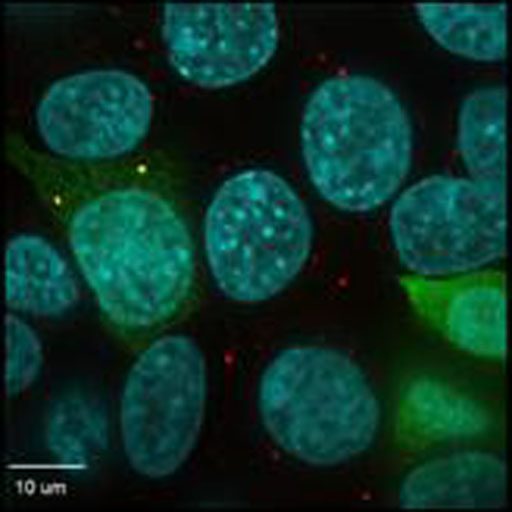Novel Microprotein Functions in Messenger RNA Removal Complex
By LabMedica International staff writers
Posted on 15 Dec 2016
A novel "microprotein" has been identified and shown to fulfill a cellular maintenance function by prepping nonessential messenger RNA (mRNA) for destruction and removal from the cytoplasm.Posted on 15 Dec 2016
MicroProteins are short single-domain proteins that possess the ability to interfere with larger multi-domain proteins. These protein species can be identified in plants and animals where they evolved from large proteins by successive domain-loss. In previous studies proteomic detection of non-annotated microproteins indicated the translation of hundreds of small open reading frames (smORFs) in human cells, but whether these microproteins had any function was unknown.

Image: Human kidney cells stained with a P-body marker (red) and NoBody (green). Yellow dots are where P-bodies and NoBody interact. Cell nuclei are shown in blue (Photo courtesy of Yale University).
Investigators at Yale University (New Haven, CT, USA) located a clutch of microproteins by extracting the large proteins from myeloid leukemia cells and then using liquid chromatography-mass spectroscopy proteomics to determine the amino acid sequences of all remaining small proteins.
They reported in the December 5, 2016, online edition of the journal Nature Chemical Biology that they had identified a 7000 Dalton human microprotein that interacted with mRNA decapping proteins, which remove the 5′ cap from mRNAs to promote 5′-to-3′ decay. Decapping proteins participate in mRNA turnover and nonsense-mediated decay (NMD). The investigators called their novel microprotein "non-annotated P-body dissociating polypeptide" or NoBody.
The investigators found that NoBody localized to mRNA-decay-associated RNA-protein granules called P-bodies. However, the amount of NoBody was not dependent of the number of cellular P-body elements. These results implicated NoBody as a novel component of the mRNA decapping complex and demonstrated the potential functionality of a newly discovered microprotein.
"The broadest significance of this work is that even in a well-studied biological process, a microprotein has been right there under our noses, undetected, all this time," said senior author Dr. Sarah Slavoff, assistant professor of chemistry, molecular biophysics, and biochemistry at Yale University.
Related Links:
Yale University














